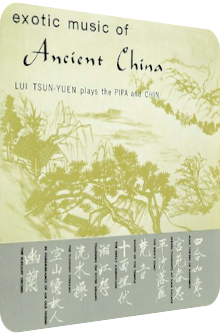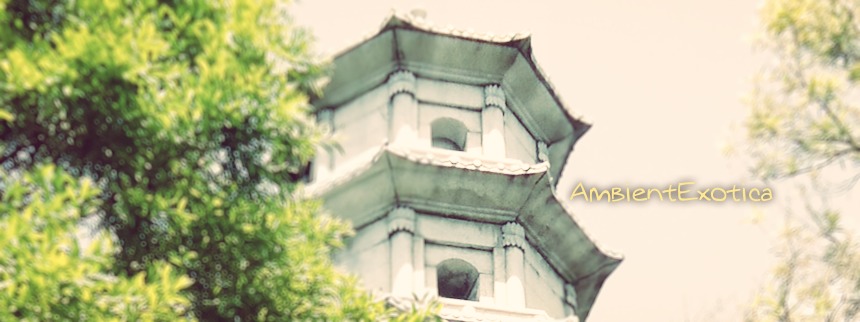
Tsun-Yuen Lui
Exotic Music Of
Ancient China
1964
Your humble reviewer interprets the term Exotica as follows: "Exotica listeners always have to keep in mind that they're not listening to the truth." I still stand by my assertion, but am keen to sometimes look beyond the purposefully plastic wonderlands when I encounter an album that shares a certain resemblance with the genre, but is otherwise very much independent and cannot be linked that easily. In the following case, I am choosing the specific work due to its textures and highly exotic material, exotic even to the die-hard genre afficionado. I am talking about Exotic Music Of Ancient China. But first things first.
The curator and player of the album, Tsun-Yuen Lui (date of birth unmentioned, died 2007) was a dedicated and highly skilled player of Chinese instruments such as the four-stringed pipa, made of ivory and bamboo, or the Chinese seven-stringed zither called chin. After coming to the United States in 1959 to play a series of concerts and promote the foreign, alienating instruments to Western ears right at the height of the Exotica craze, it was in 1961 that Lui was offered a world music program at the UCLA in Los Angeles, nowadays known as the UCLA Herb Alpert School of Music. He was the prominent face of the Department of Ethnomusicology there for 30 years; he retired in 1991. Exotic Music Of Ancient China, released around 1964 on the Lyrichord label specializing in World music to this day, is one of his many albums where he presents arcane, soothing or festive music of a largely forgotten time. It is therefore no Exotica album in the above sense of the term. It is real, serves a purpose and is produced in a humble and dedicated manner.
And yet do I think that the interest of the Exotica fan might grow, especially so since he or she enters an unknown, bewildering world comprised of nine tracks from Ancient China, played in the very same way they were played many centuries ago. Let us forget the aural Polynesian jungles and adventurous travelogs for a moment and take a closer look at both the album and the helpless reviewer who enjoys the truthfulness of this album, but has a hard time explicating his thoughts; unsurprisingly, he tries nonetheless.
Four Tokens Of Happiness is the first gateway to the world of Ancient China. According to the liner notes, the titular tokens are good luck, good prospects, prosperity and a long life, all of them important ingredients to ennoble a wedding or birthday. In contrast to many other pieces on this LP, this composition consists of dragonfly-resembling staccato riffs on the pipa, followed by sudden full stops and polyphonous bursts. The Asian feeling is definitely apparent, but to my untrained ears, it is hard to accustom to the whirring plucking and the flat melodies. But this is exactly one of the achievements of this LP, teaching Westerners a lesson by inviting them into the real, original tradition-fueled setting of Ancient China. The following Spring Thoughts At Han Palace is a pipa arrangement composed by Lady Wong-Chiang of the Han Dynasty (206 B.C. to 618 A.D). The exotic title evokes a contemplative kind of blitheness, but was actually created to show her inner conflict over the king being not interested in her, and worse, choosing another bride. This piece is much more successful in transporting tranquility. The strings are slapped in both a punchier and softer fashion, the dichotomy accruing from these varying styles may not result in catchy melodies – in the Exotica sense – but allows the listener to feast on the textures, the different implied surfaces of the liquedous highs and bamboo-like lows.
Whereas The Bird’s Song is about the eponymous animal experiencing a late autumn panorama and thus features quickly whirling pipa strings with additional claves and a surprising bonfire-evoking rhythm shift into frantic, sizzling-hot climes, Sound Of The Temple uses the pipa’s harmonies to resemble gongs and bells, a noble endeavor that is hard to achieve. Tsun-Yuen Lui’s take does not resemble these chime devices in the slightest, but sounds terrific due to its dreamy tone sequences, the aquatic decay of each slap and the almost plinking iridescence of the evoked peacefulness. Having no real beginning or end, the sequence of micro-vignettes persuade me and make it a soothing piece with no sudden full stops or rhythmic changes.
The Great Ambuscade is the centerpiece of this LP. It is exactly ten minutes long, written by Chin Han-Tse circa 581 A.D. and depicts the military conflict between the kingdoms Han and Chu. It is divided into 18 (!) parts which only the greatest connoisseur can tell apart with ease. Rest assured that the gallons of acid, bile, tension and wrath of this program music are spread all over the diorama. This piece is based on a strict formula, and it is this formula coupled with the given background information that curiously enough make it one of the most accessible compositions: usually a tone sequence is introduced by Tsun-Yuen Lui and is then repeated in an increasingly hasty or downright frantic manner. These shock-and-awe tactics allow the listener to get to know a short motif before it bedazzles him or her due to the brutal tempo in which it is played. Naturally, a composition about a real war is not a Sunday afternoon topic for Exotica listener, but again, it is the formula that allows Occidental fellows to gain access to its structure.
While the beautiful Yearning On River Shiang depicts, according to the liner notes, "nostalgic scenes of lost love" and may well be the pipa arrangement of the album which is easiest to digest as it consists of a slowly meandering, majestically solemn interplay of sound, sustain and silence, Yu-Po Ya’s The Flowing Streams which was created around 550 B.C. opens the soundscape for the first time, as even I can relate to the given prospect: the melody is created in such a way that the listener shall feel as if he or she is on a small boat. The darker pipa strings sound gorgeously wooden and bamboo-like, resembling the material of the boat. The waves are literally glinting, the texture of the chin seems to change dramatically, even though it remains the same instrument! It is one of my favorite performances of this LP, and even I can relate to the beauty of it.
The penultimate In Remembrance Of An Old Friend consists of the reflections of an old hermit thinking about his long-lost friend; this piece of over seven minutes relies as much on emptiness and nothingness as it does on pipa strings. The feeling is never crestfallen or sad rather than strangely withdrawn into itself. For my taste, it is a bit too long as the surfaces and patterns do not change over the course, but this very assertion only tells you about my lack of submerging into this piece. I still deem it more valuable than the energetic material. The over ten minutes long chin outro The Elegant Orchid is said to be composed by Confucius in 550 B.C. who gazed on beautiful orchids in an otherwise desolate valley, a topos not unfamiliar in the Hollywood machinery called Exotica. The plasticity of this soothing piece is noteworthy for its many tone pitches. They do never clash with each other, but rise slowly and lead to almost ethereal regions or otherwise stay in earthen surroundings. The last two minutes are probably the mellowest, as the chin tones almost sound like silkened sine waves while still encapsulating the Chinese characteristics.
Tsun-Yuen Lui has shown me my limits. I cannot provide truly helpful descriptions, for I am a poor soul in regard to traditional Chinese music and do know next to nothing about the tonal palette of the pipa and the chin, their different micro-tones, half-tones and timbres. But I like the sound, the texture and surface of these instruments which are so highly unusual in the Americanized transformations of Asian motifs. I am aware of Tak Shindo playing the Japanese koto and shamisen/samisen as a guest musician for Martin Denny and on his own albums, but that’s about it. I am therefore glad about having inherited this LP, which I have reviewed in an admittedly limited way to carve out the differences between the deliberate Hollywoodization which is so firmly established in the Exotica genre and the truthful origins of traditional music. To be clear: Exotica takes the best parts from many genres and uses the strangest instruments one can find, but is always keen on delivering more or less hummable melodies, clearly targeting Occidental ears. It is a refreshing change for me to step out of this glitzy fake world with its grim savages, sunken cities, Hawaiian beachscapes and jungle adventures which I so love.
Exotic Music Of Ancient China is the real deal, played by a well-known educator and teacher of Chinese music. I do have my favorites, but only because some of the melodies or settings are luckily touching a few accidental Western chords. Sound Of The Temple is an Ambient piece by today’s standards that may not have a story arc due to its string of bell-mimicking segues and interludes, but succeeds in delivering a meditative calm which was not created in order to cash in, but is beamed from an entirely different and far-away millennium to the ears of the contemporary listener. The Flowing Streams with its many textures and timbres is equally gorgeous, as the Chinese lecturer manages to depict a wooden boat in a beautiful canyon of sunlight-reflecting waves with the help of one single instrument. It is a gorgeous piece! Unfortunately, the music of Tsun-Yuen Lui is not available as a digital download, let alone on CD, but the label Lyrichord is still operating, and since they are making their back catalog available bit by bit, chances are that Exotic Music Of Ancient China might manifest itself sometime in the future, for two of Lui's other albums, Chinese Classical Masterpieces For The Pipa And Chin as well as China’s Treasures, have already been transcoded, proving that the situation is not that hopeless.
Exotica Review 198: Tsun-Yuen Lui – Exotic Music Of Ancient China (1964). Originally published on Mar. 30, 2013 at AmbientExotica.com.
